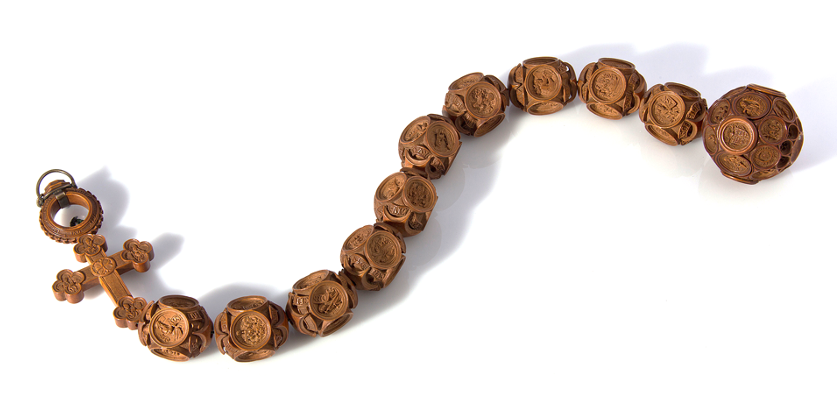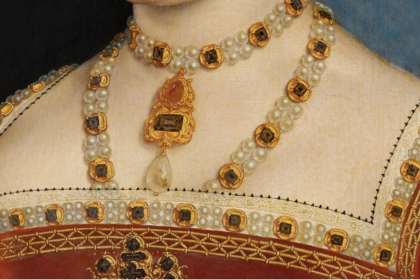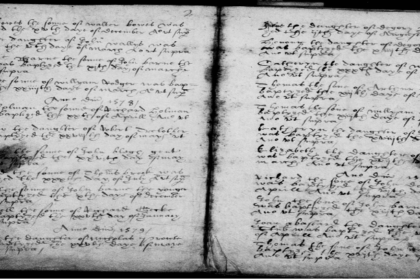These spectacular rosary beads are believed to have belonged to Henry VIII and Katherine of Aragon. No written records survive relating to this beautiful item, so most of what we know about them has been deducted from the rosary itself.
The beads are what is known as a decade paternoster. During this time, rosaries were called paternosters, and that is what these beads would have been called by Henry and Katherine. It wasn’t until the mid-16th century that the name evolved. The 10 small beads are called aves, and each represents the recitation of a Hail Mary. The final large bead is the paternoster bead, representing the Lord’s Prayer. This bead is hinged, opening to reveal a carving of the Mass of St Gregory and the Adoration of the Virgin and Child by Angels.
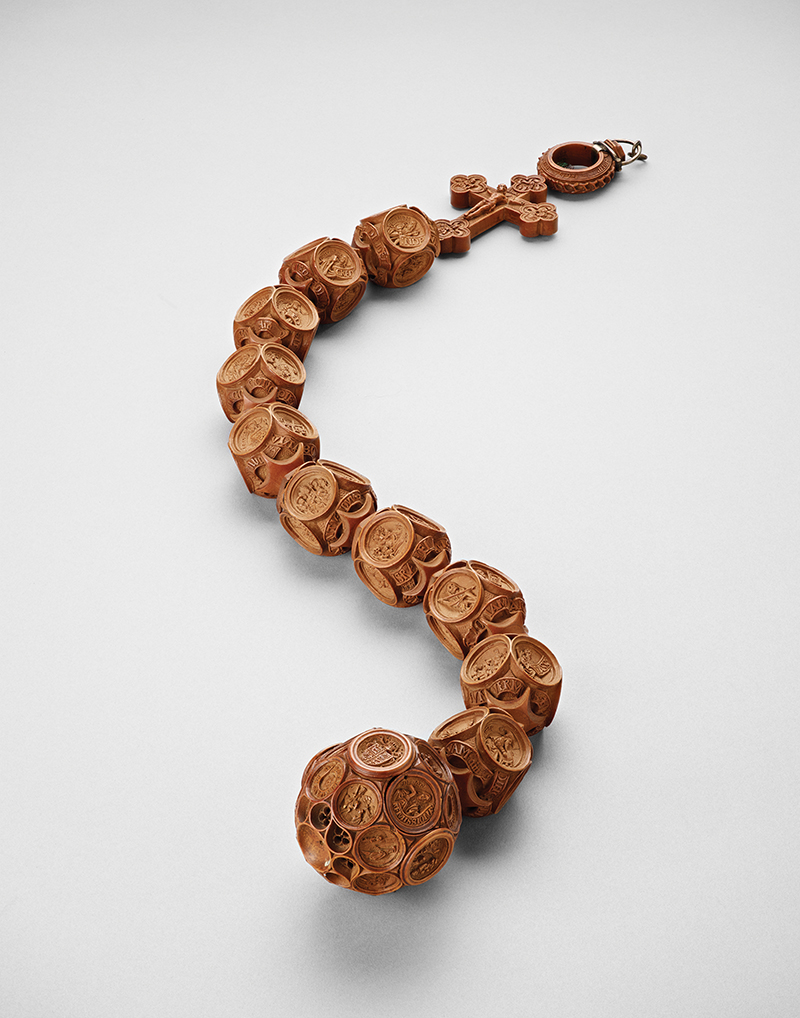
The rosary is exquisitely, minutely carved. Each bead has three rows of eight roundels, each depicting religious and biblical scenes: each has an Apostle; text from the Apostles’ Creed; a figure of Hebrew Scripture, and some other Christian theme. The Metropolitan Museum of Art provides a partial description:
Bead 1: Last Judgement; Judgement of Solomon
Bead 2: God in Majesty; Christ Child in Glory; Habakkuk Feeding Daniel in the Den of Lions
Bead 3: Annunciation; Nativity; Death of Isaiah
Bead 4: Ascension; Transfiguration; Murder of Amos
Bead 5: Resurrection; Death and Elijah Raising the Widow’s Son
Bead 6: Crucifixion; Entombment; David before the Ark
Bead 7: Members of the Church; Martyrdom of Jeremiah
Bead 8: Descent and Harrowing of Hell; Death of Zachariah
Bead 9: Creation of the Heavens; Christ Child in the Sun; Moses Receiving the Ten Commandments
Bead 10: Baptism of Jesus; Pentecost
The rosary is made of boxwood, a material that was favoured by Dutch artists. The style is reminiscent of an artist named Adam Dircksz. Though there is no carved initials to identify the artist, it seems likely that the rosary was at least made in the same workshop as Dircksz.
We can say with almost absolute certainty that they were owned by Henry and/or Katherine because around the letters ‘h e 8’ and ‘k a’ are carved into the paternoster bead, as well as the royal arms of England. In fact, on this bead there is a scene of a cardinal saying Mass. A man and a woman look on from a gallery; these are believed to represent Henry and Katherine. Given this ownership, we can also say that the beads were probably created at some point between their marriage in 1509, and Henry’s initial interest in a divorce in 1526.

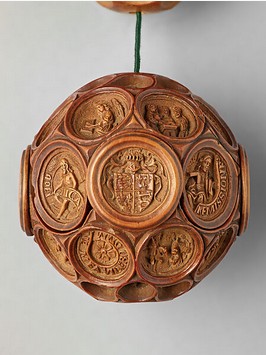

Little is known about the history of the item; the first reference we have to it is in 1844, when it was bought by the Duke of Devonshire, who wrote:
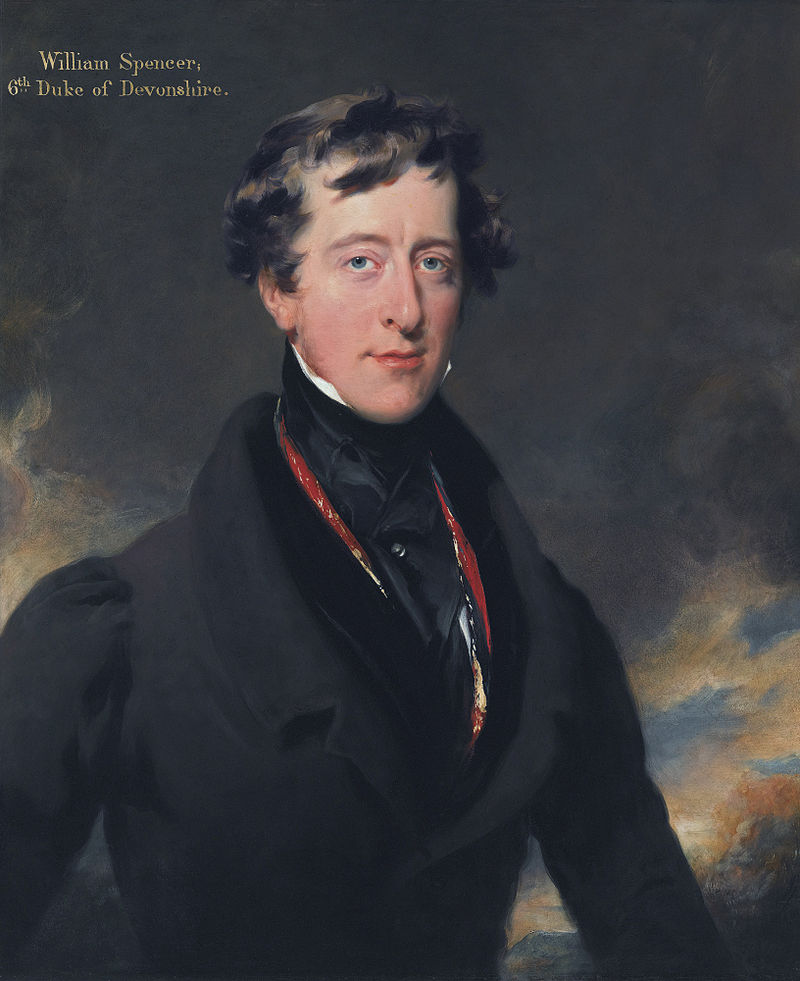
‘Since his [Henry VIII’s] time it has belonged to the Pere de la Chaise, who left it to the establishment of the Jesuits at Paris, and, when their goods were sold, it was bought by the Abbé Brotier, editor of Tacitus; and the nephew of Brotier sold it to Messieurs Rundell and Bridge, and they to me. It cost £200. Was that much or little?’
The ‘Pere de la Chaise’ would be one François d’Aix de La Chaise, a French Jesuit priest born in 1624 and died in early 1709. How certain this provenance is, we cannot say; it is also unclear how this piece would come to belong to him, nor where it was prior to his ownership.
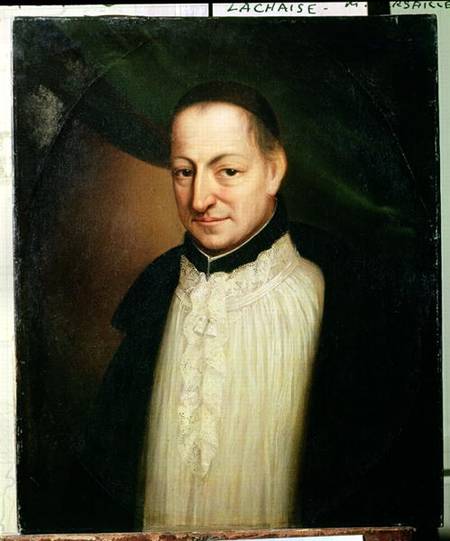
Given Henry’s religious reforms, it has been suggested that Katherine of Aragon kept the beads after their separation, perhaps eventually passing to her daughter; but this is pure speculation. It is perhaps made more likely by the fact that as part of Henry’s wide sweeping religious reform legislation, paternosters were actually made illegal in 1534. This does not seem to have been particularly enforced, as their inventories as queen show that both Jane Seymour and Catherine Howard had numerous paternosters; a reflection of their Catholic upbringings.

Regardless of its precise history, this paternoster is a spectacular piece of art. The Duke of Devonshire questioned paying £200 for the beads in 1844; but even though that is the equivalent of £20,341.12 in today’s money, I would still say that he got a bargain for this priceless piece of art and history.
Detailed images of each bead can be seen on the Metropolitan Museum of Art’s website: https://tinyurl.com/2r7zbs68

